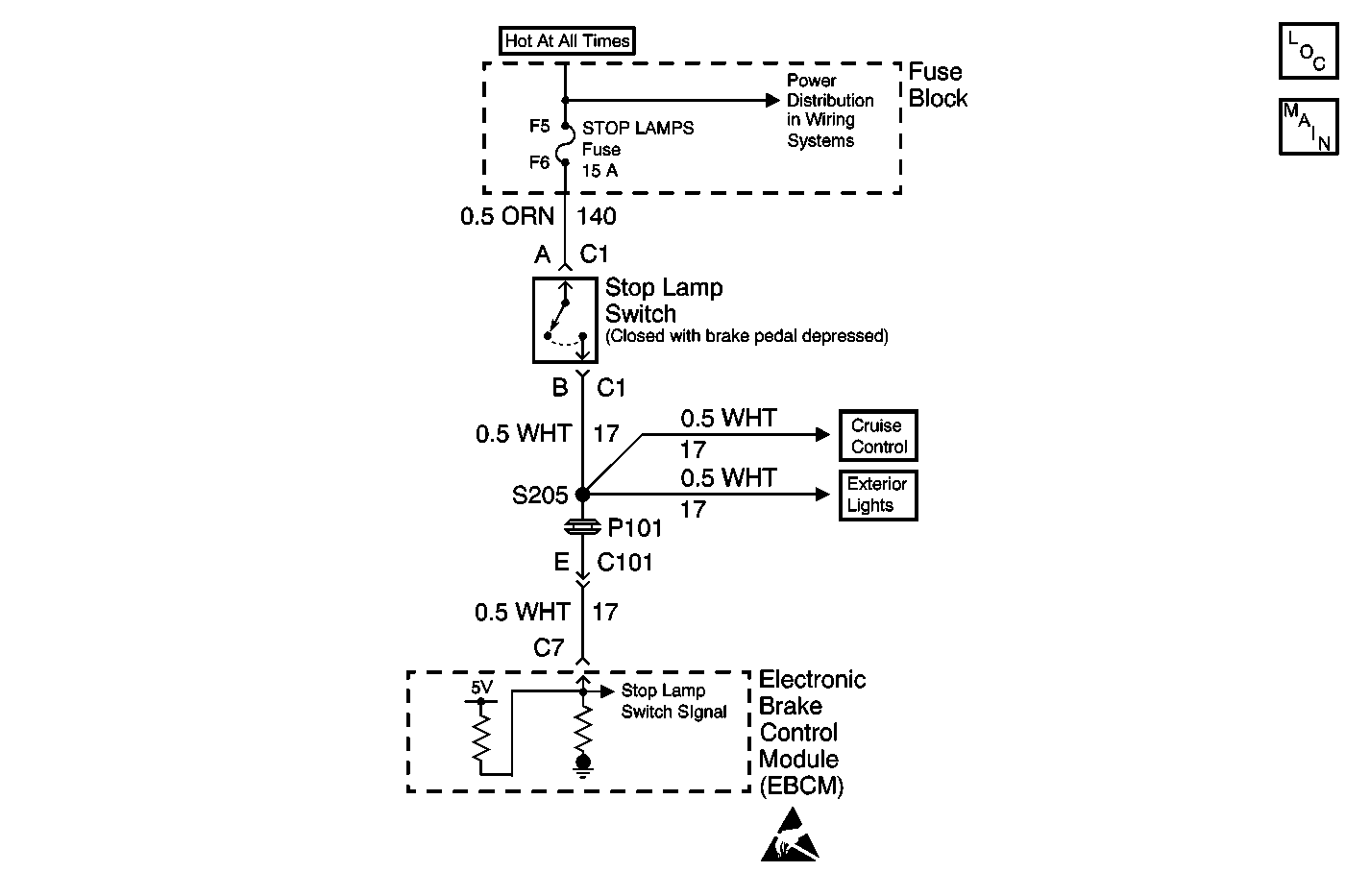
Circuit Description
This DTC is used to detect an open Stoplamp Switch in the non-ABS mode. The EBCM looks for a deceleration rate that would indicate braking action and verifies this assumption by requiring several repeats of this detection method. In each case, TCS will not be available since no Stoplamp Switch voltage is seen by the EBCM.
Conditions for Running the DTC
The ABS conditions and the braking conditions are normal.
Conditions for Setting the DTC
DTC C1291 is set after the stoplamp switch remains open for three deceleration cycles. A deceleration cycle includes starting at a speed greater than 24 km/h (15 mph), then the vehicle must decelerate to 8 km/h (5 mph) for 2 seconds. The vehicle must then reach a speed less than 16 km/h (10 mph) to complete a deceleration cycle.
Action Taken When the DTC Sets
| • | A malfunction DTC is stored. |
| • | TCS is disabled. |
| • | Traction Control indicator is turned on. |
| • | ABS remains functional. |
Conditions for Clearing the DTC
| • | Condition for DTC is no longer present and scan tool clear DTC function is used. |
| • | 100 ignition cycles have passed with no DTCs detected. |
Diagnostic Aids
| • | Possible causes: |
| - | Stoplamp switch contacts open. |
| - | Stoplamp switch fuse open. |
| - | Stoplamp switch misadjusted. |
| - | Stoplamp switch fuse power feed circuit open. |
| • | It is very important that a thorough inspection of the wiring and connectors be performed. Failure to carefully and fully inspect wiring and connectors may result in misdiagnosis, causing part replacement with reappearance of the malfunction. |
| • | If any Wheel Speed Sensor DTCs are present you must diagnose them first. |
| • | An intermittent malfunction is most likely caused by a poor connection, rubbed through wire insulation, or a wire that is broken inside the insulation. |
Step | Action | Value(s) | Yes | No |
|---|---|---|---|---|
1 | Did you perform the ABS Diagnostic System Check? | -- | Go to Step 2 | |
2 |
Does the scan tool display any wheel speed sensor DTCs? | -- | Go to Step 3 | |
3 | Press the brake pedal. Do the brake lamps turn ON? | -- | Go to Diagnostic Aids | Go to Step 4 |
4 |
Did you find and correct the condition? | -- | Go to Step 13 | Go to Step 5 |
5 |
Does the scan tool display Applied? | -- | Go to Step 10 | Go to Step 6 |
6 | Test the battery feed circuit of the stoplamp switch for a short to ground or an open. Refer to Circuit Testing and Wiring Repairs in Wiring Systems. Did you find and correct the condition? | -- | Go to Step 13 | Go to Step 7 |
7 | Test the signal circuit of the stoplamp switch for an open between the stoplamp switch and the LH IP Accessory Wiring Junction Block. Refer to Circuit Testing and Wiring Repairs in Wiring Systems. Did you find and correct the condition? | -- | Go to Step 13 | Go to Step 8 |
8 | Test the signal circuit of the stoplamp switch for a short to ground. Refer to Circuit Testing and Wiring Repairs in Wiring Systems. Did you find and correct the condition? | -- | Go to Step 13 | Go to Step 9 |
9 | Inspect for poor connections at the harness connector of the EBCM. Refer to Testing for Intermittent Conditions and Poor Connections and Connector Repairs in Wiring Systems. Did you find and correct the condition? | -- | Go to Step 13 | Go to Step 11 |
10 | Inspect for poor connections at the harness connector of the stoplamp switch. Refer to Testing for Intermittent Conditions and Poor Connections and Connector Repairs in Wiring Systems. Did you find and correct the condition? | -- | Go to Step 13 | Go to Step 12 |
11 | Replace the EBCM. Refer to Electronic Brake Control Module Replacement Did you complete the repair? | -- | Go to Step 13 | -- |
12 | Replace the stoplamp switch. Refer to Stop Lamp Switch Replacement Did you complete the replacement? | -- | Go to Step 13 | -- |
13 |
Does the DTC reset? | -- | Go to Step 2 | System OK |
